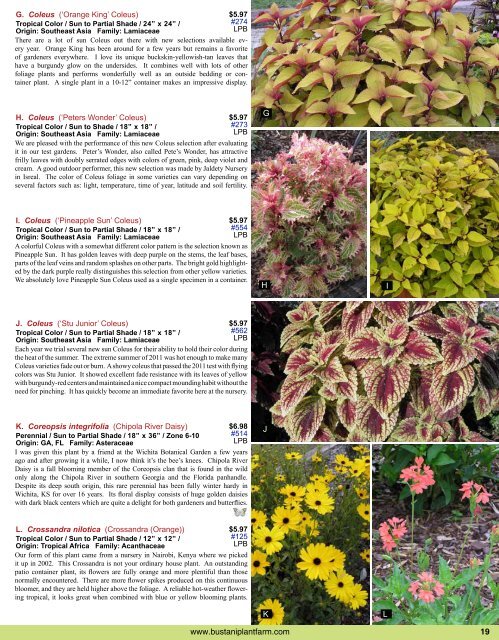Download Catalog - Bustani Plant Farm
Download Catalog - Bustani Plant Farm
Download Catalog - Bustani Plant Farm
You also want an ePaper? Increase the reach of your titles
YUMPU automatically turns print PDFs into web optimized ePapers that Google loves.
G. Coleus (‘Orange King’ Coleus)<br />
Tropical Color / Sun to Partial Shade / 24” x 24” /<br />
Origin: Southeast Asia Family: Lamiaceae<br />
There are a lot of sun Coleus out there with new selections available every<br />
year. Orange King has been around for a few years but remains a favorite<br />
of gardeners everywhere. I love its unique buckskin-yellowish-tan leaves that<br />
have a burgundy glow on the undersides. It combines well with lots of other<br />
foliage plants and performs wonderfully well as an outside bedding or container<br />
plant. A single plant in a 10-12” container makes an impressive display.<br />
H. Coleus (‘Peters Wonder’ Coleus)<br />
Tropical Color / Sun to Shade / 18” x 18” /<br />
Origin: Southeast Asia Family: Lamiaceae<br />
$5.97<br />
#274<br />
LPB<br />
We are pleased with the performance of this new Coleus selection after evaluating<br />
it in our test gardens. Peter’s Wonder, also called Pete’s Wonder, has attractive<br />
frilly leaves with doubly serrated edges with colors of green, pink, deep violet and<br />
cream. A good outdoor performer, this new selection was made by Jaldety Nursery<br />
in Isreal. The color of Coleus foliage in some varieties can vary depending on<br />
several factors such as: light, temperature, time of year, latitude and soil fertility.<br />
I. Coleus (‘Pineapple Sun’ Coleus)<br />
Tropical Color / Sun to Partial Shade / 18” x 18” /<br />
Origin: Southeast Asia Family: Lamiaceae<br />
$5.97<br />
#273<br />
LPB<br />
A colorful Coleus with a somewhat different color pattern is the selection known as<br />
Pineapple Sun. It has golden leaves with deep purple on the stems, the leaf bases,<br />
parts of the leaf veins and random splashes on other parts. The bright gold highlighted<br />
by the dark purple really distinguishes this selection from other yellow varieties.<br />
We absolutely love Pineapple Sun Coleus used as a single specimen in a container.<br />
J. Coleus (‘Stu Junior’ Coleus)<br />
Tropical Color / Sun to Partial Shade / 18” x 18” /<br />
Origin: Southeast Asia Family: Lamiaceae<br />
$5.97<br />
#554<br />
LPB<br />
Each year we trial several new sun Coleus for their ability to hold their color during<br />
the heat of the summer. The extreme summer of 2011 was hot enough to make many<br />
Coleus varieties fade out or burn. A showy coleus that passed the 2011 test with flying<br />
colors was Stu Junior. It showed excellent fade resistance with its leaves of yellow<br />
with burgundy-red centers and maintained a nice compact mounding habit without the<br />
need for pinching. It has quickly become an immediate favorite here at the nursery.<br />
K. Coreopsis integrifolia (Chipola River Daisy)<br />
Perennial / Sun to Partial Shade / 18” x 36” / Zone 6-10<br />
Origin: GA, FL Family: Asteraceae<br />
$5.97<br />
#562<br />
LPB<br />
I was given this plant by a friend at the Wichita Botanical Garden a few years<br />
ago and after growing it a while, I now think it’s the bee’s knees. Chipola River<br />
Daisy is a fall blooming member of the Coreopsis clan that is found in the wild<br />
only along the Chipola River in southern Georgia and the Florida panhandle.<br />
Despite its deep south origin, this rare perennial has been fully winter hardy in<br />
Wichita, KS for over 16 years. Its floral display consists of huge golden daisies<br />
with dark black centers which are quite a delight for both gardeners and butterflies.<br />
L. Crossandra nilotica (Crossandra (Orange))<br />
Tropical Color / Sun to Partial Shade / 12” x 12” /<br />
Origin: Tropical Africa Family: Acanthaceae<br />
$6.98<br />
#514<br />
LPB<br />
$5.97<br />
#125<br />
LPB<br />
Our form of this plant came from a nursery in Nairobi, Kenya where we picked<br />
it up in 2002. This Crossandra is not your ordinary house plant. An outstanding<br />
patio container plant, its flowers are fully orange and more plentiful than those<br />
normally encountered. There are more flower spikes produced on this continuous<br />
bloomer, and they are held higher above the foliage. A reliable hot-weather flowering<br />
tropical, it looks great when combined with blue or yellow blooming plants.<br />
G<br />
H<br />
J<br />
K<br />
www.bustaniplantfarm.com 19<br />
I<br />
L


